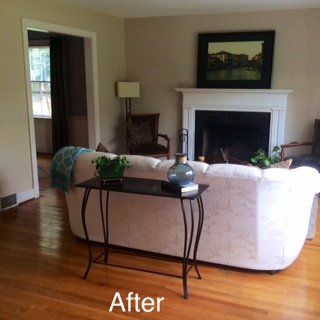Blog Post
Home Staging Tips
- By Lynn Medeiros
- •
- 14 Sep, 2015
- •
Chapter 5: Which Rooms are the Most Important for Impressing Buyers?

Secret #5 – Understand the Importance of and How to Achieve Great First Impressions
There are plenty of statistics to show that we get our first
impression of homes in less than fifteen seconds. We now
know that the first impression actually starts with the
online pictures. But once the buyer agrees to a showing, the homeowner must continue to provide a good first impression
during the actual walk-through.
The reality of first impressions is that if the initial impression is not up to par, then the remainder of the house has to be extremely spectacular to overcome that initial bad impression. In fact, the potential buyers will be inclined to notice only the negative aspects in the remainder of the house if their initial impression is bad. So that is why emphasis is generally placed on curb appeal, making sure the potential buyers have a good feeling when pulling up to the curb, and when viewing the first space upon entering the home. But what many sellers fail to realize is that this “first impression” really happens with every new room or area the potential buyer views. In other words, as buyers walk through a home, they form initial impressions with each new area.
For example, if they walk into a room and the entrance has a door that does not open or close easily and squeaks, the buyers’ impression will be that the house has not been well maintained over the years. And this happens before they even see what is in this new room! So now this new room has to overcome that initial impression, which is not an easy task. -e room now has to be spectacular, not just good, to remove those initial feelings when walking in. -erefore, each room or area, such as the backyard or garage, has to stand on its own and provide a good first impression.
But don’t just think of this as a negative aspect. If you turn this in a positive manner, then you will realize you get the OPPORTUNITY to provide a great impression with EVERY new room or area rather than just with the area first seen when entering the home! Realizing and capitalizing on this opportunity is what will set your house apart from all your competition. -is means you need to view each room or area “separately” and start with the entrance.
Each entrance needs to give an impression it has been well maintained, which could be a fresh coat of paint (especially important for front doors), assuring the door is hung properly, assuring the door handle is tight and in good shape, etc. If there is no door, assure the doorway is in good shape. And don’t overlook areas such as laundry rooms or walk-in pantries.
Their entrances need to appear well maintained, too. Once you have addressed the entrances, next view each room or area from the viewpoint buyers will see when entering. -is combined with the entrance area is truly what creates the first impression of that area. Use this as your opportunity to greatly impress the potential buyer each time they enter a new room or area! And what are ways to achieve this great impression? Well, try to have a “Wow!” factor, if possible. This is something that makes the buyer say “Wow!” when they see it for the first time. It could be something as simple as adding some fresh colorful flowers to a laundry room that is well organized and free of excess items but would otherwise come across as somewhat sterile without this blast of color and great fragrance from the flowers. Doing something a bit different with furniture arrangements can also add a “Wow!” factor or pizzazz to a room.
The reality of first impressions is that if the initial impression is not up to par, then the remainder of the house has to be extremely spectacular to overcome that initial bad impression. In fact, the potential buyers will be inclined to notice only the negative aspects in the remainder of the house if their initial impression is bad. So that is why emphasis is generally placed on curb appeal, making sure the potential buyers have a good feeling when pulling up to the curb, and when viewing the first space upon entering the home. But what many sellers fail to realize is that this “first impression” really happens with every new room or area the potential buyer views. In other words, as buyers walk through a home, they form initial impressions with each new area.
For example, if they walk into a room and the entrance has a door that does not open or close easily and squeaks, the buyers’ impression will be that the house has not been well maintained over the years. And this happens before they even see what is in this new room! So now this new room has to overcome that initial impression, which is not an easy task. -e room now has to be spectacular, not just good, to remove those initial feelings when walking in. -erefore, each room or area, such as the backyard or garage, has to stand on its own and provide a good first impression.
But don’t just think of this as a negative aspect. If you turn this in a positive manner, then you will realize you get the OPPORTUNITY to provide a great impression with EVERY new room or area rather than just with the area first seen when entering the home! Realizing and capitalizing on this opportunity is what will set your house apart from all your competition. -is means you need to view each room or area “separately” and start with the entrance.
Each entrance needs to give an impression it has been well maintained, which could be a fresh coat of paint (especially important for front doors), assuring the door is hung properly, assuring the door handle is tight and in good shape, etc. If there is no door, assure the doorway is in good shape. And don’t overlook areas such as laundry rooms or walk-in pantries.
Their entrances need to appear well maintained, too. Once you have addressed the entrances, next view each room or area from the viewpoint buyers will see when entering. -is combined with the entrance area is truly what creates the first impression of that area. Use this as your opportunity to greatly impress the potential buyer each time they enter a new room or area! And what are ways to achieve this great impression? Well, try to have a “Wow!” factor, if possible. This is something that makes the buyer say “Wow!” when they see it for the first time. It could be something as simple as adding some fresh colorful flowers to a laundry room that is well organized and free of excess items but would otherwise come across as somewhat sterile without this blast of color and great fragrance from the flowers. Doing something a bit different with furniture arrangements can also add a “Wow!” factor or pizzazz to a room.

This may involve angling a bed rather than having it up against a wall, using a sofa table as a desk, or using an ottoman as a coffee table. These “different” things will help your house stand out and make it easier for the potential buyers to remember it later. Adding some color and sparkle, such as having a bowl or vase of lemons and limes in the kitchen or decorative pillows to brighten up a room, can make a big difference, too.
Many of these small touches can be done inexpensively or with items you already have. And don’t forget about smells and odors! Make sure each room is addressed to assure your buyers will only be greeted by pleasant smells. Use sprays that remove odors, such as Febreze, rather than trying to mask odors. However, add air fresheners to each bathroom. You can find lots of options for this and can use something decorative to help add either pizzazz or a relaxing feeling to the room. If you will not have competing smells from freshly baked bread or cookies, adding an air freshener to the kitchen with an appropriate fragrance (e.g., cinnamon and spice, baked bread) is a good idea, too.
Going into great detail about how to create more “Wow!” factors is beyond the scope of this book. But keep in mind that although one rule of staging your house for the market is to neutralize, you do NOT want to make your house look dull or sterile. You still want it to have some pizzazz and make it warm and inviting to help potential buyers see what they could do with it and picture themselves living in your home. And keep in mind that a big rule with staging is “Less is More,” so don’t go overboard with the pizzazz! Adding a few larger items rather than lots of smaller items is generally the better route. Again, clutter keeps buyers from seeing your property clearly and visualizing living in it.
Once again, how can our example homeowners gain from this newest secret?
From this new secret, Bart and Babs now realize they must look at each room or area separately and assess each one’s first impression. Although this can feel overwhelming, Bart and Babs choose to look at this as an opportunity to assure any potential buyers get a great impression as they walk through the entire property rather than just a few key rooms. 0ey also realize this is an opportunity to make their house stand out from the competition.
Our homeowners decide they need some outside input from someone with expertise in this area to truly be able to assess the first impression of each room and to determine ways to add some pizzazz. 0ey start by asking their agent and friends and family for recommendations for a home stager in their area, as well as researching online.
After making their choice, Bart and Babs schedule a consultation with a stager, Abby, that will include walking through each room and area and developing a staging plan. Once the plan is developed, the homeowners can determine if they need further help or can handle the tasks themselves. By the time the appointment with Abby occurs, Bart and Babs have already worked on decluttering and cleaning out some closets and cabinets. 0ey have also looked at options for paint and flooring but plan to get Abby’s advice before moving forward. 0is gives them a good head start. During the appointment, Abby walks through each room and area with Bart and Babs, taking notes and pictures. At the end of the walkthrough, Abby shares her recommendations on what is needed to get the house ready for the market.
This includes paint and flooring recommendations, too. Abby also provides names and contact information for painting, flooring, handyman, and cleaning services Bart and Babs may choose to utilize. Bart and Babs are amazed at the amount of information that came from this short consultation and are feeling even more confident about being able to get their house sold more quickly. 0e homeowners are energized again and plan to get busy implementing the recommendations as soon as possible. 0ey also decide to have Abby come back when they are ready to do the finishing touches to get her help in assuring they have accomplished their goal of a good first impression for each room as well as some added pizzazz to help their house stand out from the competition.
Our example homeowners learned the importance of creating great first impressions with each room rather than just the initial entrance to the house or in just a couple of rooms. And they decided to turn to a local expert who is trained to know what local buyers expect and can provide a third-party perspective. Their consultation with the stager gave them the information needed to be able to get their house in show condition.
A trained stager can bring a lot of information to the table as well as service providers for the steps you cannot or choose not to do yourself. A staging consultation is generally well worth the cost. However, if you are unable to work with a stager, you can at least ask family or friends to walk through your home to provide input on what they notice to help you determine what needs to be addressed. This is extremely helpful since the longer we live in our homes, the more likely we are to overlook certain !aws or issues. An alternative that many homeowners often contemplate is whether to show their house vacant rather than occupied. Whether your home is vacant out of necessity or because you feel your house will show better with no furnishings, the next chapter delves into whether to consider showing a home vacant and what options you have that you may not have realized!
Many of these small touches can be done inexpensively or with items you already have. And don’t forget about smells and odors! Make sure each room is addressed to assure your buyers will only be greeted by pleasant smells. Use sprays that remove odors, such as Febreze, rather than trying to mask odors. However, add air fresheners to each bathroom. You can find lots of options for this and can use something decorative to help add either pizzazz or a relaxing feeling to the room. If you will not have competing smells from freshly baked bread or cookies, adding an air freshener to the kitchen with an appropriate fragrance (e.g., cinnamon and spice, baked bread) is a good idea, too.
Going into great detail about how to create more “Wow!” factors is beyond the scope of this book. But keep in mind that although one rule of staging your house for the market is to neutralize, you do NOT want to make your house look dull or sterile. You still want it to have some pizzazz and make it warm and inviting to help potential buyers see what they could do with it and picture themselves living in your home. And keep in mind that a big rule with staging is “Less is More,” so don’t go overboard with the pizzazz! Adding a few larger items rather than lots of smaller items is generally the better route. Again, clutter keeps buyers from seeing your property clearly and visualizing living in it.
Once again, how can our example homeowners gain from this newest secret?
From this new secret, Bart and Babs now realize they must look at each room or area separately and assess each one’s first impression. Although this can feel overwhelming, Bart and Babs choose to look at this as an opportunity to assure any potential buyers get a great impression as they walk through the entire property rather than just a few key rooms. 0ey also realize this is an opportunity to make their house stand out from the competition.
Our homeowners decide they need some outside input from someone with expertise in this area to truly be able to assess the first impression of each room and to determine ways to add some pizzazz. 0ey start by asking their agent and friends and family for recommendations for a home stager in their area, as well as researching online.
After making their choice, Bart and Babs schedule a consultation with a stager, Abby, that will include walking through each room and area and developing a staging plan. Once the plan is developed, the homeowners can determine if they need further help or can handle the tasks themselves. By the time the appointment with Abby occurs, Bart and Babs have already worked on decluttering and cleaning out some closets and cabinets. 0ey have also looked at options for paint and flooring but plan to get Abby’s advice before moving forward. 0is gives them a good head start. During the appointment, Abby walks through each room and area with Bart and Babs, taking notes and pictures. At the end of the walkthrough, Abby shares her recommendations on what is needed to get the house ready for the market.
This includes paint and flooring recommendations, too. Abby also provides names and contact information for painting, flooring, handyman, and cleaning services Bart and Babs may choose to utilize. Bart and Babs are amazed at the amount of information that came from this short consultation and are feeling even more confident about being able to get their house sold more quickly. 0e homeowners are energized again and plan to get busy implementing the recommendations as soon as possible. 0ey also decide to have Abby come back when they are ready to do the finishing touches to get her help in assuring they have accomplished their goal of a good first impression for each room as well as some added pizzazz to help their house stand out from the competition.
Our example homeowners learned the importance of creating great first impressions with each room rather than just the initial entrance to the house or in just a couple of rooms. And they decided to turn to a local expert who is trained to know what local buyers expect and can provide a third-party perspective. Their consultation with the stager gave them the information needed to be able to get their house in show condition.
A trained stager can bring a lot of information to the table as well as service providers for the steps you cannot or choose not to do yourself. A staging consultation is generally well worth the cost. However, if you are unable to work with a stager, you can at least ask family or friends to walk through your home to provide input on what they notice to help you determine what needs to be addressed. This is extremely helpful since the longer we live in our homes, the more likely we are to overlook certain !aws or issues. An alternative that many homeowners often contemplate is whether to show their house vacant rather than occupied. Whether your home is vacant out of necessity or because you feel your house will show better with no furnishings, the next chapter delves into whether to consider showing a home vacant and what options you have that you may not have realized!
Connect with us and allow us to help you stage your next move.
Share
Tweet
Share
Mail

